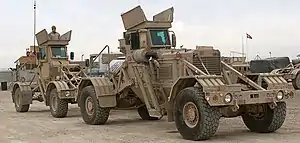Husky VMMD
The Husky VMMD (Vehicle-Mounted Mine Detection) is a South African configurable counter-IED MRAP designed for route clearance and demining. It is designed to assist in the disposal of land mines and improvised explosive devices.
| Husky VMMD | |
|---|---|
 | |
| Type | MRAP |
| Place of origin | South Africa |
| Service history | |
| In service | 1970s–present |
| Production history | |
| Manufacturer | DCD Group Critical Solutions International |
| Produced | 1970s–present |
| Specifications | |
| Mass | 18.408 to 19,841 lb (8,350 to 9,000 kg) curb weight, 20,282 to 25,022 lb (9,200 to 11,350 kg) gross weight |
| Length | 24 ft (7.34 m) |
| Height | 10 ft (3.14 m) |
| Crew | 1 2 (G2 variant) |
| Engine | Mercedes-Benz OM906LA 6.4L turbo diesel |
| Transmission | 5-speed automatic |
| Maximum speed | 45 mph (72 km/h) top speed |
The Husky is manufactured in South Africa by DCD Protected Mobility and American C-IED company Critical Solutions International.
Development
The Husky traces its lineage back to the Pookie, a Rhodesian mine clearance vehicle.
Originally used as the lead element of a mine removal convoy, the Husky was employed as part of the Chubby mine detection system. The early Chubby system comprised a lead detection vehicle (the Meerkat), a second proofing vehicle (the Husky) towing a mine detonation trailer, and a third vehicle carrying spare parts for expedient blast repair.
The Husky was initially deployed in the 1970s and used extensively by the South African Defence Force to clear military convoy routes of mines in Namibia and Angola during the South African Border War.
In the mid-1990s, DCD Group and Critical Solutions International planned to bring the technology to the U.S. and underwent a two-year foreign comparative test program with the United States Department of Defense as well as follow-on modifications and testing. In 1997, CSI was directed to produce and deliver production systems under the U.S. Army Interim Vehicle Mounted Mine Detection Program.
Over the next twenty years, the Husky went through a number of iterations and upgrade. U.S. military clearance units currently employ Husky vehicles as detection assets and clearance vehicles.
Design
The Husky is part of a class of MRAP vehicles developed from South African blast protection designs.
The sharp V-hull of the Husky reduces blast effect by increasing ground clearance and standoff from the blast, increasing structural hull rigidity, and diverting blast energy and fragmentation away from the platform and its occupants.
The Husky is designed to break apart in a blast event, allowing energy to transfer to the detachable front and rear modules rather than the critical components of the vehicle or the occupants located in the cab. Its three main components (a center cab with front and rear wheel modules) are connected by shear pins.
Critical components are engineered to break apart in a predictable fashion, preventing catastrophic damage and enabling users to quickly replace modules on site. This approach increases the lifespan of the vehicle and limits the need for recovery teams to evacuate the vehicle to maintenance facilities.
The cabin of the Husky is fitted with bulletproof glass window. There is an entry hatch on the roof.
The Husky Mk III and 2G are powered by a Mercedes-Benz OM906LA turbo diesel engine coupled with an Allison Transmission 2500 SP 5-speed automatic transmission. It can reach a maximum speed of 72 km/h and has a range of 350 km.[1]
Variants
Husky Mk I
First Husky production model. Replaced by Husky Mk II.
Husky Mk II
Second Husky model. Replaced by Husky Mk III.
Husky Mk III
Modern single-occupant Husky model. The platform is integrated with pulse induction metal detector panels and overpass tires that enable operators to regulate tire air pressure in order to reduce the risk of initiating land mines without causing detonation. The Mk III, like other Husky models, is engineered in a modular, frangible configuration.
Husky 2G
Two-occupant version of the Husky Mk III. Development of the Husky 2G was prompted by the need to conduct longer missions and employ multiple detection systems. The Husky 2G was designed with added high sensitivity detectors, ground-penetrating radar, video optics suites, and remote weapon stations. These additional components required a second operator to manage the additional workload, hence the required two occupants.
Equipment
The Husky is capable of carrying the following equipment and payloads:
- Autonomous vehicle upgrades
- Rocket-propelled grenade armor and netting
- Smoke grenade launchers
- Electronic countermeasures
- Remote weapon station
- Robotic arms
- Blowers
- Water diggers
- Thermal cameras
- Optics suite
- Mine rollers
- Rhino Passive Infrared Defeat System
- Mine plows
- Proofing rollers
- Electrostatic discharge
- RedPack repair kit
Operators
Husky Mk III
Husky 2G
- Islamic Republic of Iran Army
- Iraqi Army
- Turkish Army
- Spanish Army[3]
- Royal Saudi Land Forces
- Egyptian Army
- Jordanian Army
- Latvian Army
- United States Army (limited fielding in support of Operation Enduring Freedom)
Recognitions
The Husky was listed on the U.S. Army’s Top Ten inventions of 2010.[4]
References
- Stiff, Peter. Taming the Landmine.
- Camp, Steve; Heitman, Helmoed-Römer. Surviving the Ride: A Pictorial History of South African-Manufactured Mine-Protected Vehicles.
- "Husky 2G Mine Detection Vehicle - Army Technology". www.army-technology.com. Retrieved 29 October 2020.
- "Engineers look for trouble on Kandahar roads". 27 September 2007.
- "Spain buys 6 Husky 2G for deployment in Afghanistan". 19 November 2012. Archived from the original on 21 January 2013. Retrieved 20 November 2012.
- David McNally, RDECOM, "Army Announces Top 10 Greatest Inventions of 2010", Militaryspot.com, 12 September 2011
External links
| Wikimedia Commons has media related to Husky VMMD. |